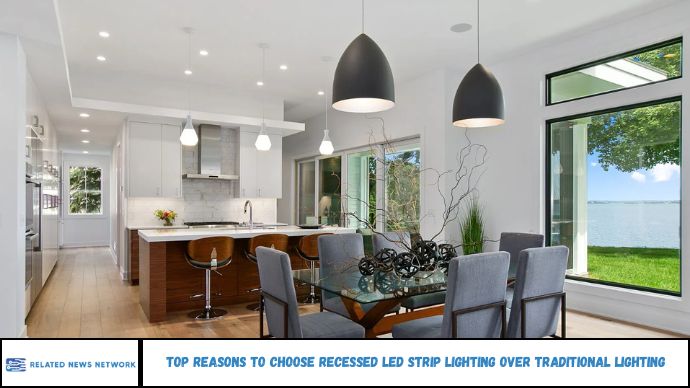Top Reasons to Choose Recessed LED Strip Lighting Over Traditional Lighting Recessed LED strip lighting offers major advantages over traditional lighting, including energy efficiency, modern aesthetics, and greater design flexibility. This article explores why homeowners, designers, and commercial spaces are making the switch—from reduced electricity bills to seamless integration with smart technology.
Why Lighting Choice Matters Today
Did you know that lighting accounts for about 15% of global electricity consumption? With growing concerns over energy use and climate impact, choosing the right lighting system is more important than ever.
Traditional lighting options like incandescent and fluorescent bulbs are quickly being replaced. Recessed LED strip lighting is now leading the way in homes, offices, and retail spaces—and not just for its sleek look.
1. Energy Efficiency That Saves You Money
One of the most compelling reasons for choosing LED strip lighting is its energy efficiency.
- LEDs consume up to 80% less energy than traditional incandescent bulbs.
- They convert more electricity into light, rather than heat.
- With long-term use, this translates into significant savings on your energy bill.
This makes LED lighting not just a stylish choice but a smart financial decision.
2. Modern Aesthetic and Seamless Design
Recessed LED strip lighting provides a sleek, low-profile appearance that’s perfect for modern interiors.
- It integrates directly into ceilings, walls, cabinets, or stairs.
- Unlike bulky fixtures, these strips disappear into the architecture.
- The result? A clean, minimalist look that elevates any room.
Interior designers often prefer recessed LED lighting for this reason—it enhances space without distraction.
3. Flexible Applications for Creative Design
Unlike fixed traditional lighting fixtures, LED strip lighting can be installed in virtually any shape or space.
- Wrap around curved walls or ceilings
- Light up under-cabinet areas or bookshelves
- Add accent lighting behind TVs, mirrors, or artwork
Customizability is a major benefit here. You can control brightness, color temperature, and even RGB color schemes with smart home apps.
4. Longer Lifespan, Lower Maintenance
Traditional lighting options have a limited life. A standard incandescent bulb lasts about 1,000 hours, and compact fluorescents last around 8,000 hours.
Compare that to LEDs:
- LED strip lights last up to 50,000 hours or more
- That’s 5–10 times longer than conventional options
- Fewer replacements = lower maintenance costs and less waste
5. Eco-Friendly and Safe
Switching to LED strip lighting isn’t just good for your wallet—it’s good for the planet.
- No harmful mercury or UV emissions
- Lower carbon footprint
- Cooler operation reduces fire risk, unlike hot incandescent bulbs
In eco-conscious design, LED lighting checks all the boxes.
6. Smart Technology Integration
Most recessed LED strips today support smart controls, allowing you to adjust:
- Brightness and color
- Timers and schedules
- Voice commands (via Alexa, Google Home, etc.)
This gives you total control over your lighting environment, something traditional lighting can’t match.
Conclusion
Yes—if you’re aiming for cost-effective, energy-efficient, and visually appealing lighting, recessed LED strip lighting is the superior choice. With a long lifespan, smart control features, and unmatched design flexibility, it’s no surprise that homeowners, architects, and business owners are leaving traditional lighting behind.
Whether you’re remodeling a room or designing a commercial space from scratch, LED strip lights deliver both form and function.
FAQs
1. Are recessed LED strip lights more energy-efficient than traditional bulbs?
Yes, they use up to 80% less energy and last significantly longer.
2. Can LED strip lights be dimmed or color-changed?
Yes, most models support dimming and color customization, including RGB options.
3. Are LED strip lights hard to install?
No, they are typically easy to install and often come with adhesive backing or mounting tracks.
4. Do LED strip lights work with smart home systems?
Yes, many recessed LED strips can be controlled via Wi-Fi, apps, or voice assistants.
5. Is recessed lighting good for small spaces?
Yes, because it’s discreet and space-saving, it works well in tight or minimalist areas.
6. Are LED strip lights safe for home use?
Absolutely—they emit very little heat, contain no mercury, and are generally low-voltage and safe.









